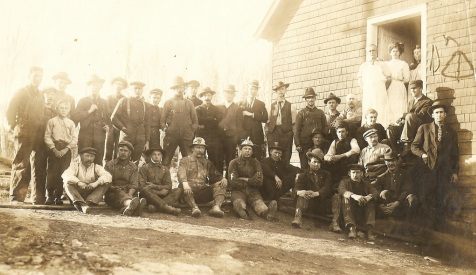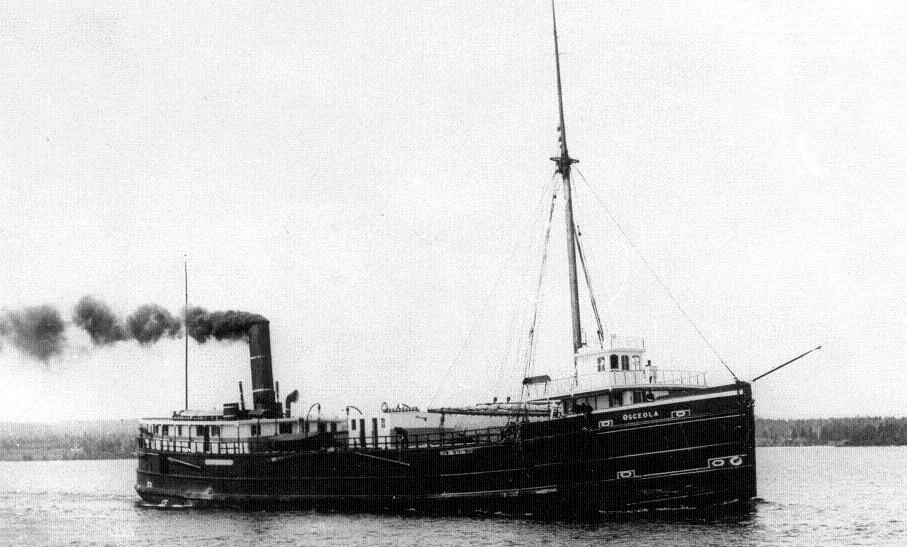A picnic in 1897 on Mackey Point on scenic Wawa Lake was the staging area for Algoma’s first gold rush when Louise Towab and William Teddy uncovered a gold laced quartz vein. While the Klondike gold fever was still fresh in everyone’s blood, one thousand hopeful souls flocked to the tiny Michipicoten River Village and Hudsons’ Bay Company post. Visions of rich placer gold fired their imaginations. Every creek bed, river and stream were staked and panned.
By September 1897, some 1,700 claims were staked. The area was proclaimed a mining division and the first Ontario Mining Recorder’s Office was set up at the abandoned Michipicoten HBCo. Post. WaWa City was surveyed and registered in 1899. The gold seekers soon discovered that there were no nuggets to be had. The most productive “gold mine” in the area was the local hotel and tavern known as the Balmoral Hotel, which sat where the Lakeview Hotel presides today.
The rugged Michipicoten mountains did reveal their worth to those more patient and practical prospectors who secured finances and resources to drill, explore and develop some of the more profitable veins hidden beneath the forest floor. Dozens of mining camps began to dot the landscape. Of note during this first gold boom were the Grace, Norwalk, Jubilee, Sunrise and Kitchie Gami. In March 1903 newspapers reported “8 gold bricks valued at $8,630 were received at the Imperial Bank from the Grace Mine, result of 4 weeks’run.” At the current price of gold these bricks would have been worth over $700,000.
The stock market crash of 1929 threw many in despair. But in Wawa the gold rich quartz veins called out to many who were driven by sheer determination to make a profit. The high unemployment rate in Sault Ste. Marie at the time led to an influx of grubstaking. Merchants would fund grubstakers to travel up the coast to Michipicoten and WaWa City to look for gold with the understanding that if gold was found, the merchants would get their share. New gold veins were uncovered, many new mines were opened and some of the original abandoned mines were dusted
off and reactivated.
Many of these grubstakers added their muscle and long hours to the hard-working crew at places like the Minto, Darwin and Parkhill mines. Labourers were told they would not be paid until the mine actually poured its first gold brick. Even though it was the “Dirty Thirties”, a headline in the Sault Daily Star on January 6, 1932 read “Michipicoten Snaps Fingers at Depression, Advances More in 1931 Than in All History.” The Parkhill was mining veins that were producing 1.9 oz/tonne at 50 to 100 tonnes per day. The price of gold per ounce in 1932 was $20.67. The price of gold today is $1685.00/oz. Local gold mines today on average produce 850 tonnes of ore per day which assay at approximately .3 oz/tonne.
During this second Wawa Gold Rush, immigrants flocked to the many mine sites which came to be known as Gold Park. Many could not speak English and were unable to find jobs anywhere else especially for the relatively higher mining wage of $.50/hour. Life in Gold Park was good. The area boasted 300 souls while the Wawa town site was little more than a supply depot. With the onslaught of World War II, iron ore became the new resource on demand and gold mines were quickly phased out. Workers and families at the Gold Park communities moved themselves, their furniture and sometimes their homes to the booming communities of Wawa and Sault Ste Marie.
Gold mining activity in Wawa was reignited in the late 1960’s, when the original Cora shaft of the Jubilee gold deposit was reopened. In the late 1980’s old mine shafts from the past 80 years were pumped out at sites like the Sunrise, Kozak, Canamax, Kremzar and Citadel. Today the high price of gold and advanced mining technology continues to encourage exploration of the original gold veins of the 1897 Wawa gold rush. Gold mining is still an important part of the unique resource based economy of Northern Algoma at Wesdome, Richmont and Edward Mines.


 RSS Feed
RSS Feed
